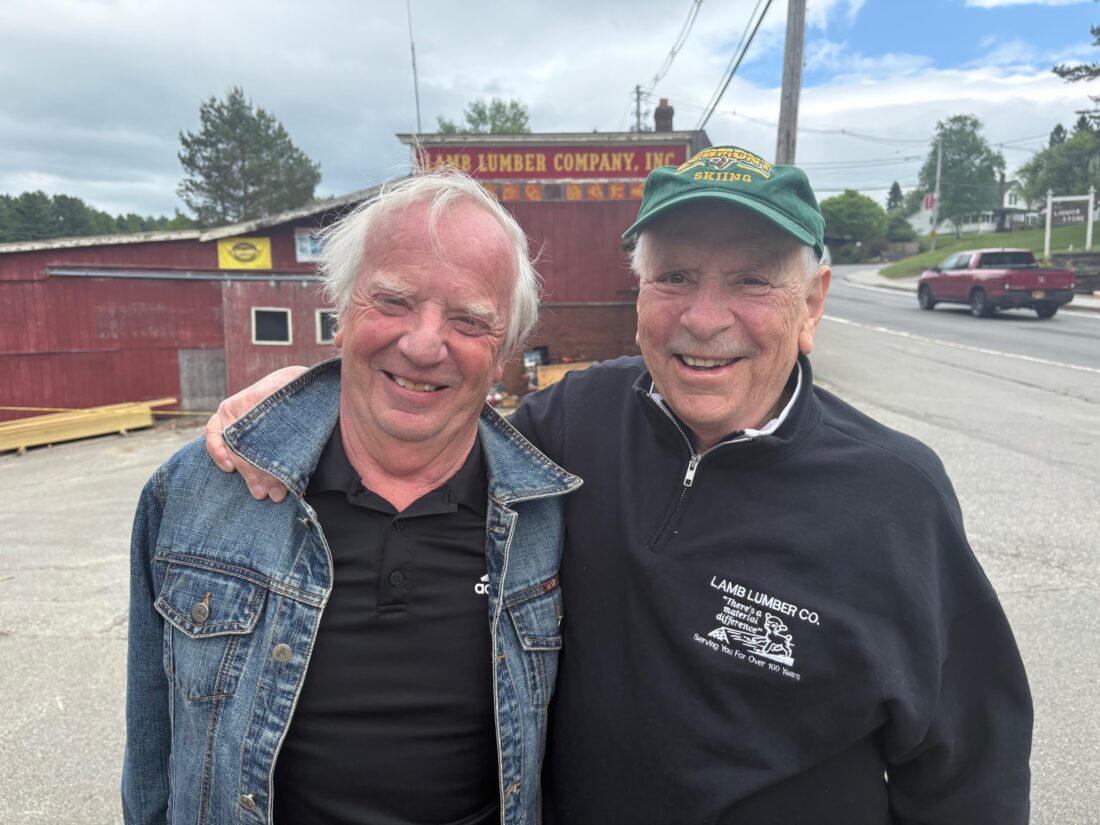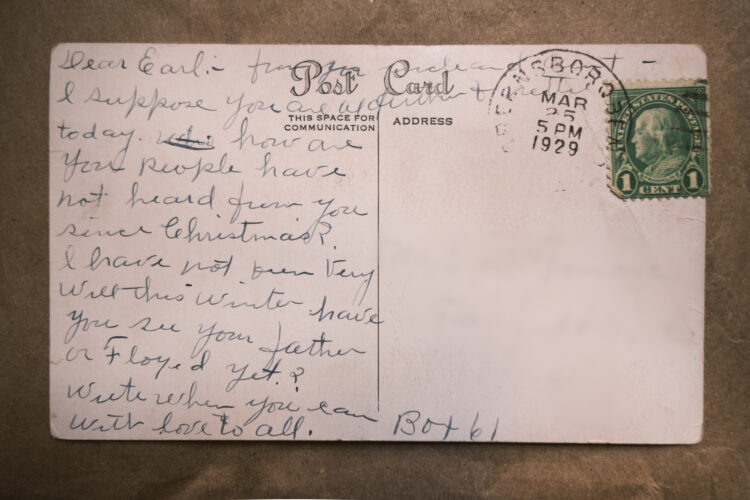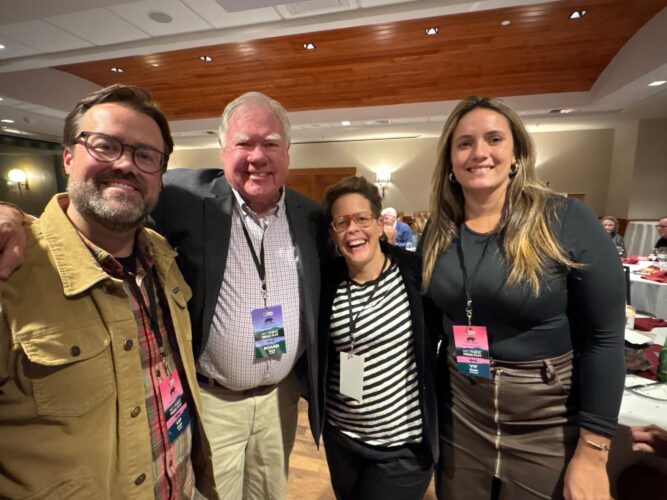ON THE SCENE: Lake Placid says goodbye to Lamb Lumber

Joe Lamb, left, poses with his uncle, Nash Lamb (Provided photo — Naj Wikoff)
Saying goodbye is hard, especially to an establishment that’s been in one’s family for over 100 years and has created work opportunities for four generations of that family, along with many others. Thus, the recent closing of Lamb Lumber is a difficult process for Joe Lamb and his family.
Lamb Lumber was one of the oldest continuously operating businesses in Lake Placid. Four remaining that have passed the century mark are the Interlaken Inn, The Pines, the Mirror Lake Inn, and the Stagecoach Inn. Lamb Lumber’s passing, though, represents a different kind of closure, one that harkens back to Hurley Brothers, Perkins’ Lake Placid Hardware, and Peacock and Torrance dairies. Of them, only Hurley Brothers remains as one of the old multi-generational family businesses.
“Lamb Lumber closing in monumental,” said Rip Torrance. “It’s been here forever. It’s a big loss.”
It’s sad to see it go,” said Joe Lamb. “The question was, does Lake Placid need a lumber yard? It’s 3.2 acres of commercial property in the village with a foundation on the Chubb River. Would a restaurant or a small hotel that would employ more people make more sense? After all, we are a resort community.”
These family-owned businesses invested in the community across several generations in many ways that are hard to fathom fully. Other multi-generational businesses, such as the Crowne Plaza, owned and led by the Lussis, and the Mirror Lake Inn, now owned by the Weibrechts, and the Holderied’s Golden Arrow Resort are very invested in the community. The Lamb-Nash family, though, was one of the families that helped create the village. (The Nash family built their house about 1852, located where the High Peaks Resort Lake House now stands.)
The Lambs and the Brewsters, the other major early land owner, gave away lots near Mirror Lake (aka Bennet Pond) to help entice people to move to Lake Placid in the first place at a time when traveling up from Keene or Wilmington was a difficult stagecoach or wagon ride through the Wilmington Notch or from Keene by way of the Old Mountain Road on the backside of Pitchoff, now the Jackrabbit Trail.
In the mid-1920s, the Lambs started with a lumber mill located where the Dack Shack is now. Crews cut trees and floated them down Lake Placid lake in large booms. Shortly after, they built a yard at their present location to create a base for receiving and sending shipments by train.
Joe Lamb’s grandfather, Vern Sr., owned and operated the yard and his brother Will Lamb, the mill. To increase people’s ability to finance homes and businesses, Joe’s grandfather also founded the Bank of Lake Placid in 1916 and hired its first president, Fred Mader. Under Joe’s dad, Vern, the yard expanded to become a mini-Lowe’s selling appliances, paints, hardware, and other construction and household needs.
Like the Perkins and Hurley families and the Bank of Lake Placid, the Lambs often gave people credit and time to pay off bills or debts that would be near impossible to get today as for them, it was another way of investing in the community, helping people create a life, and get through the harsh winters. They invested in people, and in doing so, they created tremendous loyalty and helped support a collective community spirit that resulted in a kind of volunteerism that has resulted in Lake Placid constantly punching above its weight.
“Around Christmas time, for people that couldn’t afford a stove or a refrigerator, my dad and our mom Winnie always made sure they had something,” said Tracy Lamb.
Early on, the Lambs became gung-ho about winter sports, aided a bit by the seasonal nature of the lumber business. They became avid athletes, in particular in skiing sports, ski coaching, and event organizing. They appreciated the economic and social benefit of winter sports ushered in by the Lake Placid Club, which included the 1932 Winter Olympics.
As a consequence, when the year-round economy was hurting, particularly in the forties, fifties, and early sixties, a time when many businesses closed for the winter, Vern Lamb Jr. and his colleagues Bob Allen, Ardell Anderson, Art Devlin, Rev. J. Bernard Fell, Norman Hess, Serge Lussi, Ron MacKenzie, Luke Patnode, Bob Peacock, Jack Shea, Shirley Seney and Bunny Sheffield knew that for the community to survive, they needed to do something dramatic. They set their sights on hosting another Winter Olympics, even though the debt on the 1932 arena still hadn’t been fully paid off.
Multiple rejections didn’t sway them; they kept bidding, improving their pitch, and pinning Lake Placid pins on as many people’s lapels as possible.
“They were our greatest generation,” said Joe Lamb. “Our town was dying, and they gave it a future.”
While they all played crucial roles, in many respects, without Vern Lamb, the Games would not have happened as he developed and pushed through their environmental plan; in doing so, he had to outwit the Sierra Club, which had successfully limited the Squaw Valley Games and helped drive the campaign that killed Denver officials from hosting the 1976 Games.
They now had Lake Placid in their sights. Better than anyone, Vern Lamb knew the stakes and who to recruit so Lake Placid’s bid could succeed.
“He beat them,” said Vern’s brother Nash.
Lake Placid has never had better ambassadors than the Lambs. Former Nordic Combine Olympian Joe Lamb coached the U.S. Olympic team for the Sarajevo Games for two decades starting in 1961, served as a U.S. Ski & Snowboard representative to the International Ski Federation (FIS), also serving as the Vice Chair of the FIS Nordic Combined Committee, and has been inducted in several major Halls of Fame.
For over 50 years, Tracy Lamb has been a Team USA and Team Canada biathlon coach, team leader, official and IBU Technical delegate. He helped the U.S. and Canada win their first medals ever in biathlon. He led the Chula Vista Olympic Training Center and has coached and helped develop other Olympic sports, summer and winter.
Winnie and Vern Lamb are in the Lake Placid Hall of Fame, with Winnie a former president a former president of the Adirondack 46ers. Brother Nash is a much-decorated Vietnam War medical “dust off” evacuation pilot, winning the Distinguished Flying Cross. Kathy Lamb is a much-beloved nurse. It would take two columns to list all the local, national, and international contributions, local scholarships, awards, and accolades that the Lambs have contributed and continue to contribute.
Thus, to write that the closing of Lamb Lumber is hard is an understatement, as the business and what it has made possible is an investment in the community that has no bottom.
“The reality of the finality of it is in many was harder than the actual termination,” said Nash Lamb.
Consider this: In 1979, Joe Lamb, who had not jumped in several years, was on borrowed skis on top of the tower, ready to do down as one of the inaugural jumpers, when he was asked to hold. At that moment, the then chair of the Lake Placid Olympic Organizing Committee, Ron Mackenzie, in the judge’s tower, had a heart attack and collapsed into the arms of Nash Lamb, there to watch his nephew jump.
(Naj Wikoff lives in Keene Valley and has been writing his column for the Lake Placid News since 2005.)


